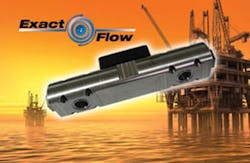Exact Flow’s dual-rotor meter is an example of a new breed of turbine flowmeters that feature advanced technology, such as ceramic bearings, bearing diagnostics, and pressure compensation, that are enabling this traditional meter design to attract attention in a wider range or applications.
Photo courtesy of Exact Flow
Despite competition from ultrasonic, multiphase, and other new-technology flowmeters, turbine flowmeters remain and will continue to maintain a viable role for a variety of applications. In particular, they excel at measuring clean, steady, medium- to high-speed flow of low-viscosity fluids. They offer simplicity, turndown, and the capability of customizing solutions for various applications.
Turbine meters have a significant cost advantage over ultrasonic and Coriolis meters, especially in larger pipe sizes, although suppliers report increasing difficulty competing with ultrasonic and magnetic flowmeters in large line sizes. The price of turbine meters may also compare favorably to DP flowmeters, especially in cases where one turbine meter can replace several DP meters. Users who are already familiar with turbine technology and don’t want to spend the extra money required to invest in a new technology are likely to stay with turbine meters.
Suppliers report that some customers are choosing electronic-based multipath ultrasonic meters over mechanical-based turbine meters due to less maintenance and non-intrusive designs. However, they also say that the higher costs of the meters and the high costs to calibrate them, combined with the uncertainty of the in-service accuracy and performance, is causing them to take a fresh look at turbine meters.
Turbine meter suppliers have made technology improvements to enhance reliability. Many of these improvements have involved making the moving parts—a traditional source of concern regarding maintenance and repair—more reliable. By making the ball bearings out of more durable material, such as newly developed ceramics and synthetic sapphires, turbine suppliers have been able to add significantly to the life of the bearings. This is important, since some customers select new-technology meters over turbine meters simply because turbine meters have moving parts that are subject to wear.
Other product enhancements that are available today include the new “dual-rotor design” being promoted by Exact Flow and other manufacturers. The dual-rotor design increases the effective operating range of turbine meters in the smaller line sizes. This innovation specifies that the two rotors turn in opposite direction, with the first rotor being upstream from the second and acting as a flow conditioner. Flow is then directed back to the second rotor. The rotors are hydraulically connected, and will continue to turn as the flow decreases even at very low flowrates. This innovation has enhanced turbine flowmeters’ suitability in low-flow applications. Other recently introduced improvements include bi-directional flow, self-lubrication, and significantly reduced pressure drop.
Some turbine meters for utility measurement are being displaced by magnetic and ultrasonic meters. However, turbine meters still retain a price advantage over ultrasonic and magnetic meters, and for this reason they will continue to be sold into the industrial gas flow measurement market.
Turbine meters for oil applications are widely used in trucking terminals for loading hydrocarbons into trucks, and for offloading them from trucks. They are also used in aviation applications. Here, turbine meters compete with positive-displacement and Coriolis flowmeters. Some users are making the switch to Coriolis meters in these distribution applications. Some turbine meters are also used for in-plant measurement within refineries and chemical plants.
Jesse Yoder, Ph.D., is president of Flow Research Inc. in Wakefield, Mass., a company he founded in 1998. He has 25 years of experience as an analyst and writer in process control. Dr. Yoder specializes in flowmeters and other field devices, including pressure and temperature products. Dr. Yoder can be reached at [email protected].
About the Author
Jesse Yoder
Jesse Yoder, Ph.D., is president of Flow Research Inc. He has 30 years of experience as an analyst and writer in instrumentation. Yoder holds two U.S. patents on a dual-tube meter design and is the author of "The Tao of Measurement," published by ISA. He may be reached at [email protected]. Find more information on the latest study from Flow Research, "The World Market for Gas Flow Measurement, 4th Edition," at www.gasflows.com.

